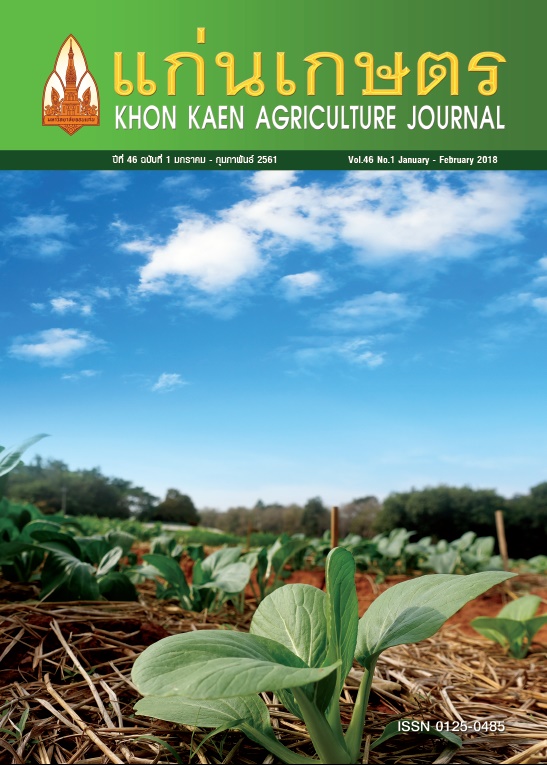การเสริมน้ำมันมะพร้าวในอาหารต่อสมรรถนะการเจริญเติบโต คุณภาพซาก สัณฐานวิทยาของลำไส้ และจำนวนโอโอซิสต์เชื้อบิดในไก่เนื้อ
Main Article Content
บทคัดย่อ
การศึกษาครั้งนี้มีวัตถุประสงค์เพื่อศึกษาผลการเสริมน้ำมันมะพร้าวในอาหารไก่เนื้อต่อสมรรถนะ การเจริญเติบโต คุณภาพซาก สัณฐานวิทยาของลำไส้ และจำนวนโอโอซิสต์เชื้อบิด โดยใช้ไก่เนื้อสายพันธุ์ Cobb 500 คละเพศอายุ 7 วัน จำนวน 360 ตัว วางแผนการทดลองแบบสุ่มสมบูรณ์ แบ่งกลุ่มทดลองออกเป็น 5 กลุ่ม กลุ่มละ 3 ซ้ำ ซ้ำละ 24 ตัว โดยมีกลุ่มทดลองได้แก่ กลุ่มที่ 1 กลุ่มควบคุม (C) กลุ่มที่ 2 กลุ่มควบคุมที่เสริมยากันบิด (Salinomycin 0.05%; CS) กลุ่มที่ 3 กลุ่มที่เสริมน้ำมันมะพร้าว 1% (CO1) กลุ่มที่ 4 กลุ่มที่เสริมน้ำมันมะพร้าว 2% (CO2) และกลุ่มที่ 5 กลุ่มที่เสริมน้ำมันมะพร้าว 3% (CO3) จากการศึกษาพบว่า ในไก่เนื้อช่วงอายุ 7-21 วัน กลุ่มที่เสริมน้ำมันมะพร้าว 2% มีอัตราการแลกเนื้อดีกว่า (FCR) กลุ่มที่เสริมยากันบิด และกลุ่มที่เสริมน้ำมันมะพร้าว 1% (1.36, 1.57 และ 1.62 ตามลำดับ; P<0.05) ขณะที่กลุ่มที่เสริมน้ำมันมะพร้าว 1%, 2% และ 3% ในช่วงอายุ 21-49 วัน และช่วงอายุ 7-49 วัน มีสมรรถนะ การเจริญเติบโตและคุณภาพซากทุกกลุ่มการทดลองไม่แตกต่างกัน (P>0.05) ผลต่อลักษณะสัณฐานวิทยาของลำไส้เล็ก พบว่าไก่เนื้อกลุ่มที่เสริมน้ำมันมะพร้าว 2% มีสัดส่วนความสูงของวิลไลต่อความลึกของคริปท์ (Villi/Crypt ratio) ในลำไส้เล็กส่วนของดูโอดินัมและไอเลียม (4.71 และ 6.34 µm) สูงกว่ากลุ่มควบคุม (3.17 และ 4.02 µm) (P<0.05) ส่วนผลต่อจำนวนโอโอซิสต์เชื้อบิดพบว่า กลุ่มที่เสริมยากันบิดมีจำนวนโอโอซิสต์เชื้อบิดต่ำกว่าทุกกลุ่มการทดลอง ในลำไส้เล็กส่วนไอเลียม (P<0.05) นอกจากนี้จำนวนโอโอซิสต์เชื้อบิดในไส้ติ่งของกลุ่มที่เสริมน้ำมันมะพร้าว 1% มีแนวโน้มต่ำกว่ากลุ่มควบคุม (P>0.05) จากผลการทดลองสรุปได้ว่าการเสริมน้ำมันมะพร้าวในอาหารที่ระดับ 2% เป็นระดับที่ส่งผลดีต่อสมรรถนะการเจริญเติบโตในช่วงอายุ 7-21 วัน มีสัณฐานวิทยาของลำไส้เล็กให้ดีกว่ากลุ่มควบคุม และกลุ่มที่เสริมน้ำมันมะพร้าว 1% มีแนวโน้มลดจำนวนโอโอซิสต์เชื้อบิดในไส้ติ่งของไก่เนื้อ ทั้งนี้การเสริมน้ำมันมะพร้าวทุกระดับไม่ส่งผลเสียต่อคุณภาพซาก
Article Details
เอกสารอ้างอิง
ดุจดาว คนยัง, ณัฐพร จันทร์ฉาย และวิรัตน์ หาญธงชัย. 2553. การใช้พืชสมุนไพรไทยในการเพิ่มสมรรถภาพการเจริญเติบโต และควบคุมโรคบิดในไก่เนื้อ. รายงานผลการวิจัยมหาวิทยาลัยแม่โจ้. มหาวิทยาลัยแม่โจ้ วิทยาเขตจังหวัดแพร่, แพร่.
มานพ ม่วงใหญ่. 2547. โรคบิดในไก่. บริษัท โนวาร์ตีส (ประเทศไทย) จำกัด, กรุงเทพฯ.
เยาวมาลย์ ค้าเจริญ. 2556. การใช้สมุนไพรในอาหารสัตว์ไทยมุ่งสู่มาตรฐานอาเซียน. แก่นเกษตร. 41(4): 369-376.
สัญชัย จตุรสิทธา. 2553. เทคโนโลยีเนื้อสัตว์. พิมพ์ครั้งที่ 3. ภาควิชาสัตวศาสตร์และสัตว์น้ำ, คณะเกษตรศาสตร์, มหาวิทยาลัยเชียงใหม่, เชียงใหม่.
สำนักวิจัยเศรษฐกิจการเกษตร. 2559. ภาวะเศรษฐกิจการเกษตรไตรมาส 3 ปี 2559. กองนโยบายและแผนพัฒนาการเกษตรและสำนักวิจัยเศรษฐกิจการเกษตร สำนักงานเศรษฐกิจการเกษตร. แหล่งข้อมูล: https://goo.gl/9kAG9B. ค้นเมื่อ 22 มกราคม 2560.
อภิรมย์ เจริญไชย, สุกัญญา นาคสุนทร และสาทิส นิยมศักดิ์. 2550. สภาวะการใช้สารปฏิชีวนะในอาหารสัตว์โครงการมาตรฐานฟาร์มในภาคตะวันออกเฉียงเหนือตอนบน.ศูนย์วิจัยและพัฒนาการสัตวแพทย์ภาคตะวันออกเฉียงเหนือ (ตอนบน), ขอนแก่น.
Awad, W.A., K. Ghareeb, S. Abdel-Raheem, and J. Bohm. 2009. Effects of dietary inclusion of probiotic and symbiotic on growth performance, organ weights, and intestinal histomorphology of broiler chicken. Poult. Sci. 88: 49-55.
Blake, D.P., and Tomley F.M. 2014. Securing poultry production from the ever-present Eimeria challenge. Trends Parasitol. 30(1): 12-19.
Bowman, D.D., and R.C. Lynn. 1999. Georgis’ Parasitology for Veterinarians 7th edition. W.B. saunders Company. Philadelphia, USA.
Cogliani, C., H. Goossens, and C. Greko. 2011. Restricting antimicrobial use in food animals: lessons from Europe. Microbe. 6(6): 274-279.
Dong, L., W. AN, W. LI, L.L. ZHANG, X. ZHONG, and T. WANG. 2013. Effects of different fat sources on the small intestine morphology in the broiler. Chin. J. Ani. Husb. Vet. Med. 1: 1-5.
Duncan, D. B. 1995. Multiple Rang and Multiple F Test. Biometrics. 11: 1-42.
Fahmy, Z. H., E. Aly, I. Shalsh, and A. H. Mohamed. 2014. The effect of medium chain saturated fatty acid (monolaurin) on levels of the cytokines on experimental animal in Entamoeba histolytica and Giardia lamblia infection. Afr. J. Pharm. Pharmacol. 8(4): 106-114.
Garcia, N. M., G. M. Pesti, and R. I. Bakalli. 2000. Infiuence of dietary protein level on the broiler chicken’s response to methionine and betaine supplements. Poult. Sci. 79(10): 1478-1484.
Hayashi, M. 1992. Feed additive for livestock and feed for livestock. United State Patent, USA.
Martins-Rodrigues, M.A., D.A. Oliveira Silva, E.A. Taketomi, and F.J. Hernandez-Blazquez. 2007. IgA production, coliforms analysis and intestinal mucosa morphology of piglets that received probiotics with viable or inactivated cells. Pesq. Vet. Bras. 27(6): 241-245.
NRC. 1994. National Research Council. Nutrient requirement for poultry. Ninth Revised Ed. National Academy Press, USA.
Rayan, P., Stenzel D., and McDonnell P.A. 2005. The effect of saturated fatty acids on Giardia duodenalis trophozoites in vitro. Parasitol. Res. 10: 1432-1435.
SAS-University-Edition (c). 2015. SAS Institute Inc, Cary, NC, USA.
Tan, G.H., and K. Long. 2012. Preliminary study of anticoccidial activity of medium chain fatty acids (MCFA) and their corresponding monoglycerides on broiler chicken coccidiosis. Int. J. Biotech. Well. Indus. (1): 134-141.
Timbermont, L., A. Lanckriet, J. Dewulf, N. Nollet, K. Schwarzer, F. Haesebrouck, R. Ducatelle, and F. Van Immerseel. 2010. Control of Clostridium perfringens-induced necrotic enteritis in broilers by target-released butyric acid, fatty acids and essential oils. Avian Pathol. 39: 117-121.
Uni, Z., S. Ganot, and D. Sklan. 1998. Posthatch development of mucosal function in the broiler small intestine. Poult. Sci. 77: 75-82.
Wang, J., X. Wang, J. Li, Y. Chen, W. Yang, and L. Zhang. 2015. Effects of dietary coconut oil as a mediumchain fatty acid source on performance, carcass composition and serum lipids in male broilers. Asian Australas. J. Anim. Sci. 28: 223-230
Yuniwarti, E.Y.W., W. Asmara, W.T. Artama, and C.R.Tabbu. 2012. Virgin coconut oil increases the productivity of broiler chicken post avian influenza vaccination. Anim. Prod. 14: 192-198.
Zeitz, J. O., J. Fennhoff, H. Kluge, G. I. Stangl, and K. Eder 2015. Effects of dietary fats rich in lauric and myristic acid on performance, intestinal morphology, gut microbes, and meat quality in broilers. Poult. Sci. 94: 2404-2413.
Zentek, J., S. Buchheit-Renko, F. Ferrara, W. Vahjen, A.G. Van Kessel, and R. Pieper. 2011. Nutritional and physiological role of medium-chain triglycerides and medium-chain fatty acids in piglets. Anim. Health Res. Rev. 12: 83-93.


